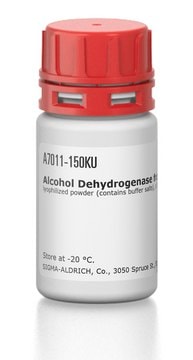10109339001
Roche
Sorbitol Dehydrogenase (SDH)
from sheep liver
Sinónimos:
SDH, Sorbitol Dehydrogenase, sorbitol
About This Item
Productos recomendados
biological source
sheep liver
form
lyophilized
specific activity
~40 units/mg protein (At 25 °C with D-fructose as the substrate.)
mol wt
115 kDa
packaging
pkg of 10 mg (60 mg lyophilizate)
manufacturer/tradename
Roche
concentration
0.16 mg/mL Biuret
technique(s)
activity assay: suitable
color
white
optimum pH
7.5
solubility
water: 60 mg/mL, clear, colorless
suitability
suitable for ELISA applications
NCBI accession no.
UniProt accession no.
application(s)
life science and biopharma
foreign activity
ADH <0.00182%
GIDH <0.00152%
Glucose-DH <0.00182% (NAD as coenz.)
LDH <0.00167%
MDH <0.00198%
NADH oxidase 0.00532%
storage temp.
2-8°C
Gene Information
sheep ... SORD(101115280)
General description
Sorbitol dehydrogenase (SDH) from sheep liver has a molar mass of 152kDa. The protein is a tetramer of four identical subunits. Each of these subunits has 355 amino acid residues, of which 10 are cysteine residues. Each subunit contains a zinc atom at the active site, which is associated with three protein ligands and a water molecule. The zinc atom associates with the oxygen of the sorbitol hydroxyl or of the fructose carbonyl interconverted during catalysis.
Application
Biochem/physiol Actions
Quality
Unit Definition
Physical form
Preparation Note
Stabilizers: Maltose is used as stabilizer.
Storage conditions (working solution): An aqueous solution is stable at 2 to 8 °C for several weeks.
Storage and Stability
Other Notes
Storage Class
11 - Combustible Solids
wgk_germany
WGK 1
flash_point_f
does not flash
flash_point_c
does not flash
Certificados de análisis (COA)
Busque Certificados de análisis (COA) introduciendo el número de lote del producto. Los números de lote se encuentran en la etiqueta del producto después de las palabras «Lot» o «Batch»
¿Ya tiene este producto?
Encuentre la documentación para los productos que ha comprado recientemente en la Biblioteca de documentos.
Los clientes también vieron
Nuestro equipo de científicos tiene experiencia en todas las áreas de investigación: Ciencias de la vida, Ciencia de los materiales, Síntesis química, Cromatografía, Analítica y muchas otras.
Póngase en contacto con el Servicio técnico











